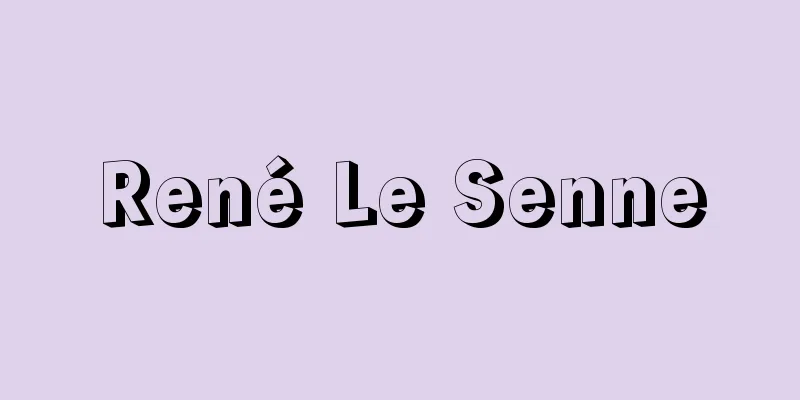Nagai Kafu - Nagai Kafu

|
Novelist, essayist, and playwright. Born on December 3, 1879 in Koishikawa, Tokyo. His real name was Soukichi. His pseudonyms included Danchotei Shujin and Kinpu Sanjin. His father, Kyuichiro, was from the Owari Domain and studied in the United States before becoming a government official. He later served as branch manager of Nippon Yusen Shanghai and Yokohama. He was a pupil of Washizu Kido (Nobumitsu) and was well-known as a Chinese poet. His mother, Tsune, was Kido's daughter. [Takemori Tenyu] Youthful RebellionKafu studied at the Higher Normal School's attached ordinary middle school, then went on to study Chinese at the Foreign Language School, before dropping out. In 1898 (Meiji 31), he became a disciple of Hirotsu Ryuro and aspired to become a novelist, but he also trained to be a rakugo performer and kabuki playwright. He started out with realistic works in the style of Ryuro, and wrote works such as "Hell's Flowers" (1902), which are said to have been influenced by the Zoraism that soon became popular. In 1903 (Meiji 36), he traveled to America to study, and after a stay in France, returned to Japan in 1908. This experience abroad deepened his appreciation of the individualism and traditional culture of Western civil society, and gave him the opportunity to hone his innate critical qualities and sensory flexibility. [Takemori Tenyu] The Viewpoint of a New ReturneeAfter returning to Japan, Kafu was welcomed as a breath of fresh air into the mainstream naturalist literary world with his "Amerika Monogatari" (1908), and published "France Monogatari" (1909, banned), "Sumida River", "Cold Smile", and other works in succession. His sense of discomfort with Meiji civilization as a new returnee and his aesthetic tendency to embrace the sentiments of the downtown area and entertainment district were clearly evident in his works. In 1910, he was appointed professor of literature at Keio University, founded "Mita Bungaku", and became one of the central figures in the anti-naturalist camp. At the same time, the High Treason Incident was discovered, and the resulting authoritarian repressive policies further fueled Kafu's long-held resentment towards Meiji society, leading him to consciously adopt a hedonistic and comical attitude. This is reflected in works such as "Shinbashi Yawa" and "Chiryanagimado no Yuubae". During this period, he also translated a collection of poems titled "Sangoshu" and attempted to write a play called "Autumn Farewell." [Takemori Tenyu] Alienation and fulfillmentThe transition from the Meiji to the Taisho era was also a turning point for Kafu personally. After his father's death, he divorced his wife and married Fujikage Shizue, a woman from the entertainment industry, but they divorced again. This kind of behavior, which was contrary to what is called junpu (good manners) and good morals, worsened his relationship with his younger brother and relatives, and even though he was the eldest son and heir to the family, he was instead excluded and alienated from the "family." In 1916 (Taisho 5), he resigned from Keio University for health reasons and retired from editing Mita Bungaku. He sold his father's house in Okubo Yocho-cho and eventually purchased a wooden Western-style house in Azabu, which he named Henki-kan, and began a free-spirited life as a single man. However, his talent as a writer was fully developed, and he produced masterpieces of Taisho-period literature such as "Arm Competition" (1917) and "Okame Sasa" (1920). It was also during this period that he began writing "Danchotei Nichijo" (1917). [Takemori Tenyu] Curiosity and spectatingHis creative ability seems to have declined with the transition from the Taisho to the Showa era, but his curiosity turned to the new customs after the Great Kanto Earthquake, and this eventually led to the creation of works in the Showa period that depicted the cruel lives of private prostitutes, cafe waitresses, and men who lived as pimps for women. These include "The Rain's Afters" (1931) and "The Shadow Flowers." In an era when militarism was rampant, Kafu would appear every night in the Ginza and Asakusa areas, and his taste for lowlifes and narrow-mindedness increasingly became a satire of the times. "Bokuto Kidan" (1937), which explored the private brothels of Tamanoi across the Sumida River and found material there, can be said to point to the pinnacle of Kafu's literary achievement. Also during this period, he produced the opera "Katsushika Love Story." During the war, Kafu lost the opportunity to publish his works due to his anti-national policy style, but this actually encouraged his pure creative desire. After the defeat, he continued to write his works in secret. [Takemori Tenyu] The aesthetics of eccentricityHenkikan was burned down in the Great Tokyo Air Raid in March 1945, and he evacuated to Okayama via Akashi in Hyogo Prefecture, where he experienced defeat. His uncompromising wartime lifestyle was praised by journalists after the war, but his attitude of looking down on the times and observing from the sidelines remained unchanged even after the war. He was awarded the Order of Culture in 1952, and elected a member of the Japan Art Academy in 1954, but he continued to cook his own meals at his home in Ichikawa, Chiba Prefecture, and commute to Asakusa with a shopping basket, maintaining his "eccentric" aesthetic until his death. He died on April 30, 1959. The cause of death was heart failure caused by vomiting blood from a stomach ulcer. [Takemori Tenyu] The Complete Works of Kafu, all 29 volumes (second printing, 1971-1974, Iwanami Shoten) ▽ The Life of Nagai Kafu, by Akiba Taro (1976, Shunyodo) ▽ Nagai Kafu, by Isoda Koichi (1979, Kodansha) ▽ The Collected Works of Yoshida Seiichi 5 (1979, Ohfusha) ▽ The Complete Works of Showa Literature 1 (1987, Shogakukan) [References] | | | |Source: Shogakukan Encyclopedia Nipponica About Encyclopedia Nipponica Information | Legend |
|
小説家、随筆家、劇作家。明治12年12月3日東京・小石川に生まれる。本名壮吉(そうきち)。別号に断腸亭(だんちょうてい)主人、金阜(きんぷ)山人など。父久一郎は尾張(おわり)藩の出身でアメリカ留学後官吏となり、のち日本郵船上海(シャンハイ)、横浜支店長を歴任した。鷲津毅堂(わしづきどう)(宣光)の門下で漢詩人として令名がある。母恒(つね)は毅堂の娘。 [竹盛天雄] 青春の反逆荷風は高等師範附属尋常中学科を経て外国語学校清(しん)語科に学び中退。1898年(明治31)広津柳浪(りゅうろう)の門に入り小説家を志したが、その一方で落語家や歌舞伎(かぶき)作者の修業をした。当初、柳浪風の写実的作品をもって出発し、やがておりから盛んになったゾライズムの影響をいわれる『地獄の花』(1902)などを書いた。1903年(明治36)アメリカに遊学、以後、フランス滞在を経て1908年帰国する。この外遊体験は、西欧市民社会の個人主義と伝統文化への認識を深めさせ、彼本来の批評的資質と感覚的柔軟さとに磨きをかける機会を与えた。 [竹盛天雄] 新帰朝者の眼帰国した荷風は、『あめりか物語』(1908)によって、自然主義主流の文学界に新風を吹き込む者として歓迎され、『ふらんす物語』(1909、発禁)、『すみだ川』『冷笑』などを次々に発表。新帰朝者の眼(め)に映じた明治文明への違和感と下町や花柳(かりゅう)界の情趣に親しむ耽美(たんび)的傾向とが色濃く現れていた。1910年、慶応義塾大学文科教授に迎えられ、『三田文学』を創刊、反自然主義陣営の中心的存在の一人となった。おりから、大逆事件が発覚し、それに伴う強権の抑圧政策は、彼のかねてからの明治社会への反感をいっそうあおり、享楽的戯作(げさく)者的な姿勢を意識的にとらせる結果となった。『新橋夜話』『散柳窓夕栄(ちるやなぎまどのゆうばえ)』などにその反映がある。またこの時期、訳詩集『珊瑚(さんご)集』があり、戯曲『秋の別れ』などの試みもあった。 [竹盛天雄] 疎外と充実明治から大正への時代の移行は、荷風個人にとっても一つの節目にあたっていた。父の死去をきっかけに妻を離別し、花柳界出身の藤蔭(ふじかげ)静枝を正妻に迎えたがふたたび離婚した。このような、いわゆる醇風(じゅんぷう)良俗に反したふるまいは、弟や親戚(しんせき)縁者との関係を悪化させ、長男で家督相続者でありながら、逆に「家」から排除され、疎外される因となった。1916年(大正5)健康を理由に慶大を辞し、『三田文学』編集も退いた。大久保余丁町の父の邸を売り、やがて麻布に木造洋館を買入れて偏奇(へんき)館と名づけ、独身にして自由な生活に入り始めた。が、作家としての力は充実し、『腕くらべ』(1917)、『おかめ笹(ざさ)』(1920)のような大正期荷風文学の代表作が生まれた。『断腸亭日乗(にちじょう)』の起筆(1917)もこの時期のことである。 [竹盛天雄] 好奇心と傍観大正から昭和への時代の転換のなかで創作力に劣えがみえるが、関東大震災以後の新風俗に彼の好奇心は向けられ、これがやがて私娼(ししょう)やカフェーの女給、あるいは女のヒモとして生きる男たちの姿などを非情に描き出した昭和期の作品を生んだ。『つゆのあとさき』(1931)、『ひかげの花』などがそれである。軍国主義が跳梁(ちょうりょう)する時代、荷風は夜ごと銀座、浅草界隈(かいわい)に出没、その陋巷(ろうこう)趣味、狭斜(きょうしゃ)趣味はいよいよ時代への一つの風刺的意味をもってきた。隅田(すみだ)川の向こう玉の井の私娼窟(くつ)を探訪し、そこに素材を得た『濹東綺譚(ぼくとうきだん)』(1937)は、荷風文学の到達点を指し示すものといってよい。またこの時期、歌劇『葛飾(かつしか)情話』があった。戦争下の荷風は、反国策的な作風のため作品発表の場を失うが、むしろ、それは彼の純粋な創作意欲を鼓舞した。敗戦後、一斉に発表される作品は、こうしてひそかに書き続けられた。 [竹盛天雄] 「偏奇」の美学1945年(昭和20)3月の東京大空襲によって偏奇館焼亡、兵庫県明石(あかし)を経て岡山に疎開、その地で敗戦を迎えた。戦中の非妥協の生き方は、戦後、ジャーナリズムによって持ち上げられるが、時勢を白眼に視(み)て傍観する姿勢は、戦後社会に対しても変わらなかった。1952年(昭和27)文化勲章受章、1954年芸術院会員に選ばれたが、千葉県市川の自宅で自炊生活を続け、買物籠(かご)を提げて浅草通いをする「偏奇」の美学は、死に至るまで貫き通された。昭和34年4月30日没。胃潰瘍(かいよう)の吐血による心臓麻痺(まひ)であった。 [竹盛天雄] 『『荷風全集』全29巻(第二刷・1971~1974・岩波書店)』▽『秋庭太郎著『永井荷風伝』(1976・春陽堂)』▽『磯田光一著『永井荷風』(1979・講談社)』▽『『吉田精一著作集5』(1979・桜楓社)』▽『『昭和文学全集1』(1987・小学館)』 [参照項目] | | | |出典 小学館 日本大百科全書(ニッポニカ)日本大百科全書(ニッポニカ)について 情報 | 凡例 |
Recommend
Elementary particle - Soryushi (English spelling) elementary particle
The most basic building blocks of matter in the n...
Agave potatorum (English spelling) Agavepotatorum
… [Takabayashi Masatoshi]. … *Some of the termino...
underemployment
…In equilibrium in the labor market, workers who ...
Masamura Hojo
Year of death: Bun'ei 10.5.27 (1273.6.13) Year...
Consumers' Cooperative - Seikatsukiyoudokumiai
Officially, it is called a consumer cooperative, o...
Warranty - Bürgschaft
In the Civil Code, it means the assumption of resp...
《Engiyaku》 - Engikyaku
...The 12 volumes of the code were compiled in 90...
Forest Swallow (Forest Swallow) - Forest Swallow
A species of bird in the passerine family Hirundin...
Notebook - techo
A small booklet for recording memories. In today&...
Daikandaiji Temple
This is the predecessor temple of Daian-ji Temple ...
Günbel, CWvon - Günbel
…This term was coined in 1868 by German geologist...
Azumayama ruins
This archaeological site is centered on the Otsuk...
Industrial Standardization Act
This law was enacted to standardize and simplify t...
Ifjo - Ifjo
…Khan's conversion to the Yellow Hat sect was...
Balanops (English spelling)
About nine species are found on islands in the Sou...









